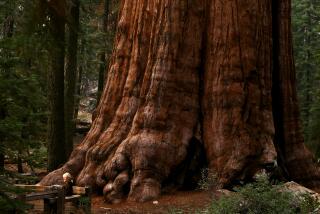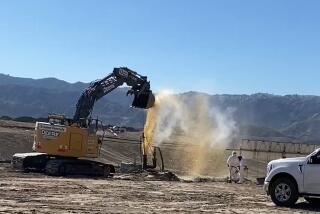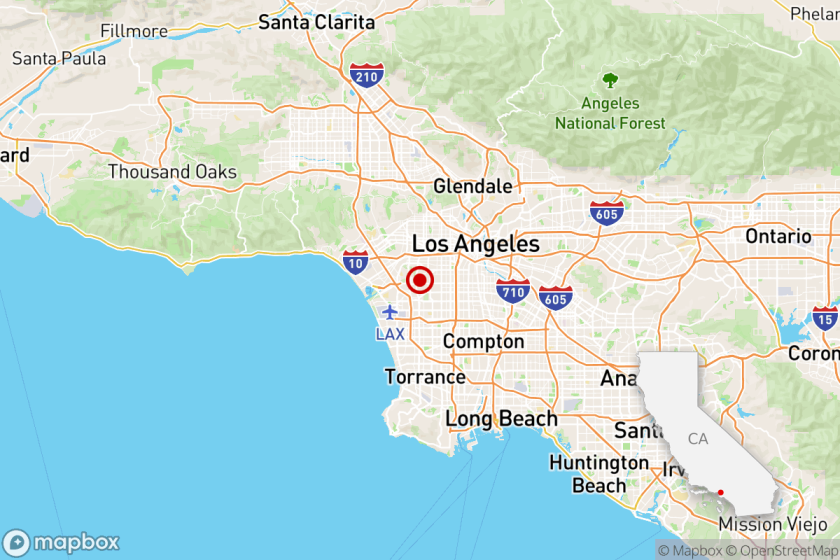A menacing air in the Central Valley
FRESNO — On bad-air days here in the Central Valley, school officials hoist red flags to warn parents and pupils that being outside is officially deemed “unhealthful for all groups.”
This winter, though, the most polluted on record, schools have not only raised red flags. On several days, they have had to send out notices saying the red flags should really be purple—indicating “very unhealthful” air — if only they had them. But such warnings have been be so rare that schools don’t even have the flags designating the most extreme conditions.
Of course, parents could just look at the sky itself.
From Stockton to Bakersfield, a haze of chemical-laced particles has tinted the air a rusty gray all winter. In the evenings there’s a charcoal stripe across the horizon. The Sierra Nevada hasn’t been visible for more than a month.
A high-pressure ridge, four miles high, sits off the West Coast, blocking Pacific storms from cleaning the air in the Central Valley. Pollution levels have spiked across California, but nowhere is it as bad as in this agricultural region.
With no rain since Dec. 7, fine particles that can embed in lungs and enter the bloodstream build up in an ever-darkening sky. Meteorologists don’t expect the weather to shift until at least the end of the month.
When Kellie Townsend returned from her Christmas vacation at the coast, she knew right away something was wrong.
“As soon as I drove into the valley, I could feel a burning in my throat,” she said.
Townsend, who works in the Earth and Environmental Sciences program at Fresno State, heeded air board warnings to stay inside. Her neighbors seemed to do the same. The only people she saw out were gardeners with leaf-blowers. For exercise there was her Lindy Hop dance class. One weekend she went to the mountains for a dose of fresh air.
But after three weeks, on a recent balmy day, the 42-year-old returned to running up and down hills near a walking trail. She purposely didn’t check the air rating — which was a red alert with about three times the amount of fine particles found in air considered healthful.
“I’m scared. I can feel that something isn’t right. I can feel the tightness in my chest,” she said. “But I get tense when I’m inside too long. I told my husband, ‘My head feels chaotic inside.’ I know what will happen — I will be coughing tonight. Maybe the damage is long term. But what do I do?”
People who live in the Central Valley are used to bad air. Surrounded by mountains on three sides, home to industrial agriculture and oil fields, and with most of the state’s long-distance big-rig traffic driving through on Interstate 5 and state Highway 99, the region historically has had some of the worst pollution in the nation.
Warnings about spikes usually go out in the summer and are directed at sensitive groups: children, older people and those with respiratory problems in a region where the asthma rate is three times higher than the national average.
Now the amount of fine particles — known as PM-2.5 — in the air is so high that a new group is affected: outdoorsy adults with no health problems. On many days, the air district, tracking hourly readings, sends out an alert: “Real Time Activity Risk Warning.”
As the weeks stretch on, people are ignoring the warnings.
Chris Bouk, a Kingsburg junior high P.E. teacher, spent a recent school week teaching his classes inside. Students were limited to only necessary movement between classrooms and school buses.
It didn’t stop Bouk, 54, from his weekend bike ride.
“I have a schedule and I want to keep it,” he said. “It’s not only cardio that’s important; you have to think abut your muscles. And it’s a mental issue — just being outside is good for you. I mean, it’s what, 72 degrees? This feels good.”
Bouk, a serious cyclist, did notice a difference.
“You can almost taste the air,” he said. “And, well, you’ve had a chest cold? It feels like that — the tightness.”
For almost two months, Dr. Pat Golden, a Fresno cardiologist and internist, has told his patients to stay inside.
On a recent afternoon, a 91-year-old woman asked for permission to just take a walk outside. He told her no. Then he went for his own brisk daily walk.
“I prefer not to see what I’m breathing, and you can see this air,” he said. “But I don’t know how to quantify the risk. I balance it against my peace of mind from being outside and moving my leg muscles. It’s a terrible choice to have to make.”
The San Joaquin Valley Air Pollution Control District board has long argued that the Central Valley should not be fined for failing to meet federal clean air standards, partly because pollution blows in during the summer from the Bay Area and even China.
At a Jan. 15 meeting, executive director Seyed Sadredin said that other parts of California also exceeding federal PM-2.5 thresholds this winter could help the Central Valley find allies in escaping penalties for what they can’t control.
He said the region would have had the cleanest winter air on record — instead of the worst — if only there wasn’t a drought.
Tom Frantz, a clean-air activist, sees a counter-argument in the dark cloud over the Central Valley during a season that usually offers easier breathing.
“It’s building up and not blowing away because we need rain. But we’ve created every bit of what we’re breathing right now. We can’t blame San Francisco or China,” he said. “What we’re seeing, is what’s ours to change.”
Frantz, 64, has not gone on his usual walks or outdoor bike rides for more than six weeks. But the third-generation farmer can’t avoid digging holes, dragging branches and other physical labor in his almond orchard.
“I find myself half-sick all the time,” he said. “I try to take it slow. But my sinuses hurt and my chest is tight.”
The weekend after the board meeting, Jamie Davidson and Madison Peterson, both 20, returned flushed and happy from a hike where they had done yoga for an hour beside a Fresno canal. It was a red alert day, but Davidson pointed out that if you looked straight up, the sky was powder blue.
“I can’t change where I’m living right now,” she said. “So I’d rather have the joy that yoga and being outside gives me than think about the bad air.”
On the banks of the San Joaquin River, Sharon and John North watched their 8-year-old son and 6-year-old daughter play beside the water.
“Essentially we’re committing child abuse by taking them outside,” John said wryly. Sharon said she and her son both had asthma and would have trouble breathing later in the evening.
“Kids need good food, good sleep and to be outside. What do you do when one of the foundations is taken away from you?” she asked. “Basically, we go outside knowing it’s going to shave some time off our lives.
“Sometimes you choose your soul.”
More to Read
Start your day right
Sign up for Essential California for news, features and recommendations from the L.A. Times and beyond in your inbox six days a week.
You may occasionally receive promotional content from the Los Angeles Times.







